UniSuper Review: Leading The Pack In Australian Super Excellence
Last Updated on 20 February 2024 by Ryan Oldnall
UniSuper has grown to have 600,000 members and $115 Billion of combined assets as of May 2023 to become one of Australia’s largest super funds. [1]
In this UniSuper Review, I will discuss the pros and cons of UniSuper. UniSuper markets itself as one of the cheapest Super Funds out there.
Read below, and you may be surprised at how affordable they are in comparison to Australia’s largest Super Fund, AustralianSuper.
Who Are UniSuper Fund?
UniSuper was first established in 1983 and was initially called Superannuation Scheme for Australian Universities (SSAU). This fund was first established for the University and Academic sector [2].
UniSuper opened its membership to All Australians in 2021 with funds under management surpassing the $100 billion mark around the same time.
UniSuper, like many other large super funds, has undergone mergers throughout its history. In December 2022, UniSuper merged with Catholic Superannuation (ACS), adding an additional $10 billion of funds to its portfolio.
Who Owns UniSuper?
UniSuper is a non-profit company owned by 37 Australian universities and is managed by a corporate Trustee called UniSuper Limited. Each of these universities has a say in the decision-making process through the Consultative Committee. [3]
How Big Is UniSuper?
According to UniSuper, they currently have 600,000 members as of May 2023 with $115 billion in combined assets [1]. For comparison, Aware Super had 1.1 million members and $125 billion under management as of May 2023 [4].
In terms of global ranking, UniSuper was found to be the 77th largest pension fund according to a worldwide study [5]. Again, for comparison, AustralianSuper Fund was found to be the 20th largest and Aware Super 46th in that same study.
UniSuper Is An Industry Super Fund
UniSuper is an industry super fund and follows a core principle of not distributing dividends or profits, as it does not have shareholders.
Instead, all funds generated are reinvested into the fund, ultimately benefiting its members.
This approach aligns with the philosophy adopted by other industry super funds, such as AustralianSuper and Australian Retirement Trust Super.
UniSuper Review – Pre-Mixed Options
High Growth Option
The High Growth Option is an investment strategy designed to achieve robust long-term growth by diversifying its portfolio across a wide range of assets, with a specific focus on both Australian and international shares.
As of July 1, 2023, the allocations with the highest weighting for this option was 45% in Australian shares and 49% in international shares.
This allocation indicates a strong emphasis on international exposure, demonstrating the desire to capitalize on global market opportunities alongside the domestic market.
The primary objective of the fund is to exceed the Consumer Price Index (CPI) by more than 4% per annum over the medium to longer term, accounting for account fees, costs, and taxes.
However, it’s important to note that due to the nature of high growth investments, there may be short-term fluctuations in returns.
Growth Option
The Growth investment option comprises a diverse portfolio primarily consisting of higher-risk assets, including Australian and international shares and fixed interest.
As of July 1, 2023, the predominant allocation of the option was 37% in Australian shares, 42% in international shares, and 14% in cash and fixed interest.
The primary objective of the balanced option is to achieve a yearly performance of more than 3.5% relative to the Consumer Price Index (CPI) over the medium to longer term.
By strategically diversifying across growth assets while incorporating defensive assets, this option aims to strike a balance between potential returns and risk management.
Balanced Option
The Balanced Option is designed to achieve medium- to long-term growth while being mindful of the possibility of short-term fluctuations.
This option offers a diverse portfolio that includes investments in shares, fixed interest, and cash.
As of July 1, 2023, the main top allocations were 30% in Australian shares, 33% in international shares, and 28% in cash and fixed interest.
The primary objective of the balanced option is to outperform the Consumer Price Index (CPI) by more than 3% per annum over the medium to longer term.
It is important to consider that while the balanced investment option aims for growth, it acknowledges the potential for short-term fluctuations.
As a result, it is structured to provide stability and moderate risk while pursuing medium- to long-term growth.
Conservative Balanced Option
The conservative balanced investment option is intentionally geared to achieve medium-term growth while maintaining a careful balance between capital stability and capital growth.
While it seeks growth, it places a greater emphasis on fixed interest and cash allocations compared to the Balanced option, resulting in a more conservative investment approach.
The top portfolio allocations of the conservative balanced option include 19% in Australian shares, 17% in international shares, 48% in cash and fixed interest.
The primary objective of the conservative balanced option is to surpass the Consumer Price Index (CPI) by more than 2% per annum over the medium term.
Although the conservative balanced option aims for growth, it acknowledges the significance of capital stability and may experience some short-term fluctuations.
The emphasis on fixed income and cash strategically contributes to providing stability to the portfolio.
UniSuper Vs Australian Super Vs Aware Super
Uni Super, Australian Super, and Aware Super have well-established performance records that are comparable. Both, Aware and UniSuper started out as having exclusive sector-specific memberships before opening to the wider public.
Each of these Superannuation funds offers comprehensive historical performance data, allowing us to assess and compare their performances over the past decade.
Throughout these comparison diagrams UniSuper is referred to as ‘US’, Aware Super as ‘AW’, and AustralianSuper as ‘AS’.
These performance and fee-based figures are from published information on each Super funds website.
UniSuper Fund Performance Comparison
UniSuper Vs Australian Super and Aware Super Performance Over 10 Years
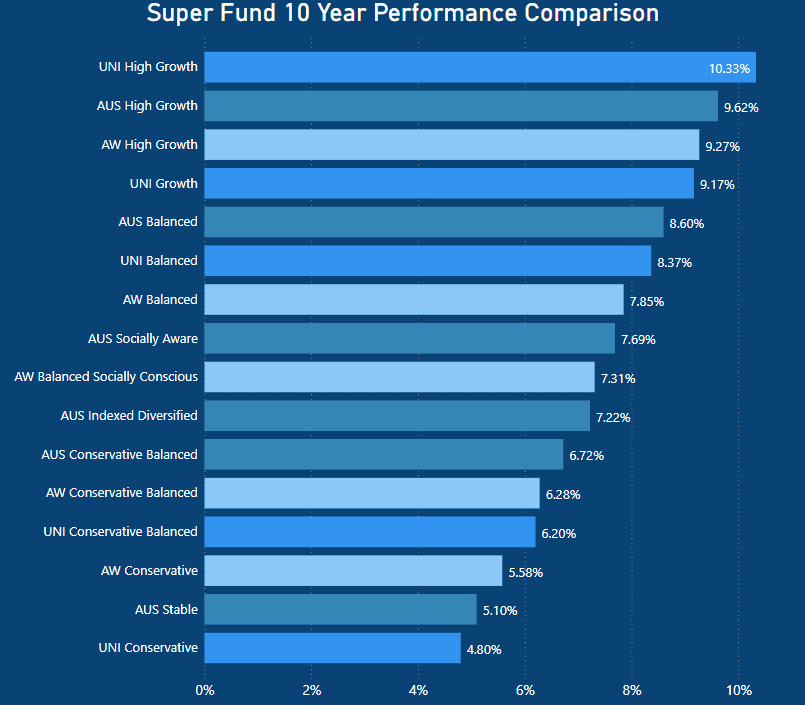
When looking at the performance of Uni Super, AustralianSuper, and Aware Super over 10 years. You can see that both UniSuper and AustralianSuper High Growth options have had the best overall returns.
UniSupers 10.33% return on their high growth option is higher than that of Australian Supers 9.62%. Aware Super’s high growth option returned 9.27% which was marginally higher than UniSupers growth option.
Aside from this we can see that the various options performed somewhat similarly between the different funds.
High Growth and Growth Options Comparison
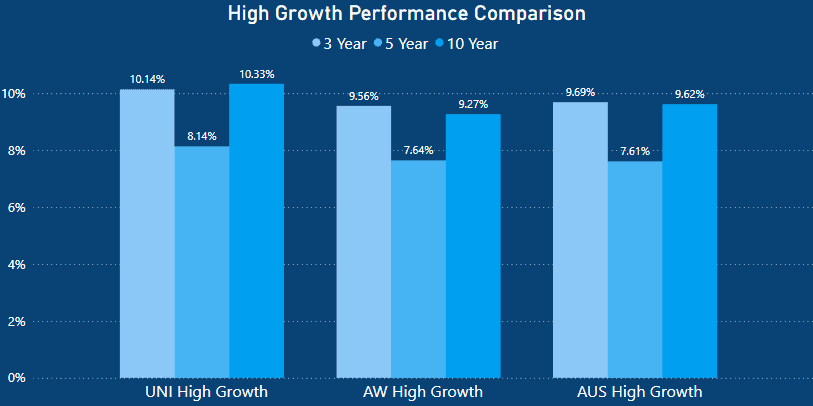
Aware Super and AustralianSuper have shown closely matched high growth performances in the short, medium, and long term. AustralianSuper has marginally outperformed Aware Super by 35 basis points over the 10 years.
However, UniSuper has outperformed both Aware Super and Australian Super over the short, medium and long term. UniSuper returned 10.14% over three years which was 0.45% better than Australian Super.
Likewise, over the medium term of 5 years, UniSuper returned 8.14% which was 0.5% higher than Aware Supers return of 7.64%.
Lastly, over the span of 10 years, UniSuper was the best performer with 10.33%, delivering 0.71% better returns that its closest competitor Australian Super.
Balanced Growth Options Comparison
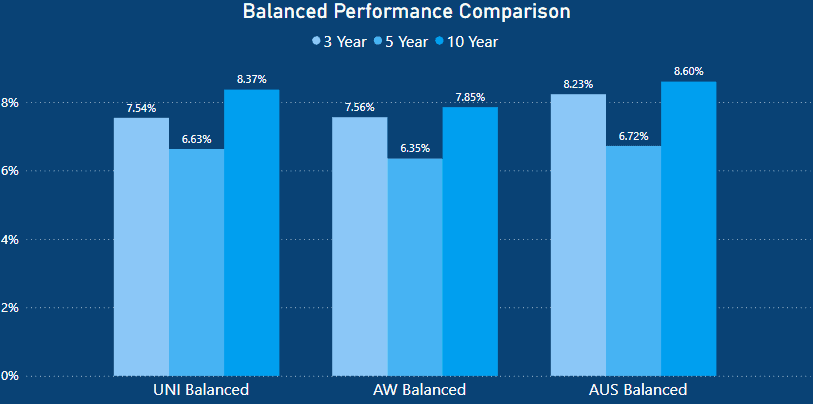
When evaluating the performance of balanced funds, Australian Super stands out as the clear winner. Their balanced option outperformed both Aware Super and UniSuper in the short, medium, and long term.
Over the 3-year short term, Australian Super’s balanced option returned 8.60%, while Aware and UniSuper returned 7.56% and 7.54%, respectively.
Likewise, in the 5-year medium-term period, Australian Super achieved a return of 6.72%, surpassing both Aware Super by more than 37 basis points.
Conservative and Stable Options Comparison
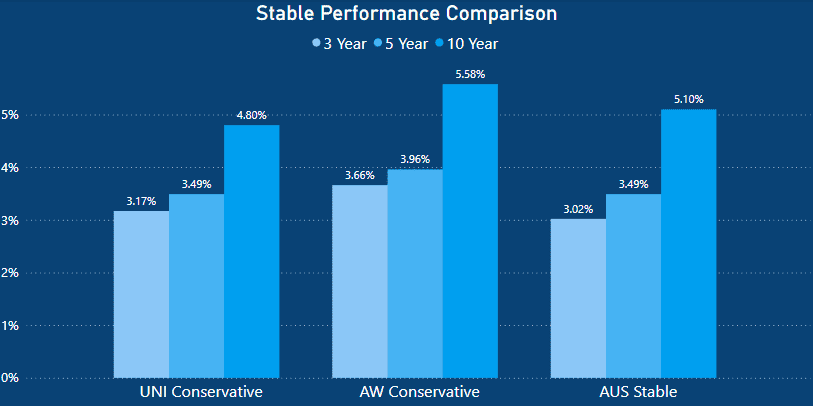
In the 3-year short-term period, Aware Super returned 3.66%, which is over 0.64% higher than Australian Supers 3.02% return.
Similarly, over the medium term, Aware Super returned 3.96%, with both Australian Super and UniSuper returning 3.49% on their respective conservative and stable options.
Lastly, over 10 years, UniSuper and AustralianSuper returned 4.80% and 5.10%, respectively. However, Aware Super delivered a significantly better return of 5.58%. This is 0.78% more than what UniSuper delivered on their conservative option.
Brief Explanation of Super Fees
Administration Fees: Super funds impose administration fees to cover the expenses associated with managing your super account. These costs include operating the call centre and providing annual statements.
Administration fees can take various forms, either a fixed amount, a percentage of your account balance, or a combination of both, often with a maximum limit per year.
Investment Fees: Investment fees and costs encompass both direct and indirect expenses related to investments.
This includes internal investment management costs, fees paid to third-party managers, custody expenses, derivative costs, and audit and administrative fees connected to managing investments.
These costs contribute to the overall expenses incurred through investment activities.
Transaction Fees: Transaction costs are additional expenses borne by members who invest in specific options.
These costs encompass various expenses related to buying or selling underlying investments, such as brokerage fees, settlement and clearing costs, stamp duty on investment transactions, and due diligence expenses.
Transaction costs for an investment option also include fees associated with individual members’ contributions, withdrawals, and switches between investment options.
The calculation of transaction costs typically relies on estimated expenses for a specific period, like the year ending on June 30, 2023.
These costs are expressed as a ratio relative to the average value of all assets in the investment option during that period.
It’s crucial to note that transaction costs can vary and are subject to change from year to year.
Performance Fees: Performance fees represent an additional cost usually beyond the regular investment and administration fees.
According to UniSuper’s product disclosure statement (PDS), the UniSuper Fund does not deduct any performance fees from members’ accounts directly.
However, certain third-party investment managers may be entitled to receive performance fees if they achieve returns that exceed a specified benchmark.
It is crucial to understand that in cases where these external managers do not perform, no performance fees are payable.
It is also worth noting that UniSuper’s performance fee is already incorporated into their investment fees and costs.
The quoted fees in the below charts include a performance fee of 0.02%, which may be deducted if the specified performance benchmarks are met.
Fee Comparison: Investment Related Fees
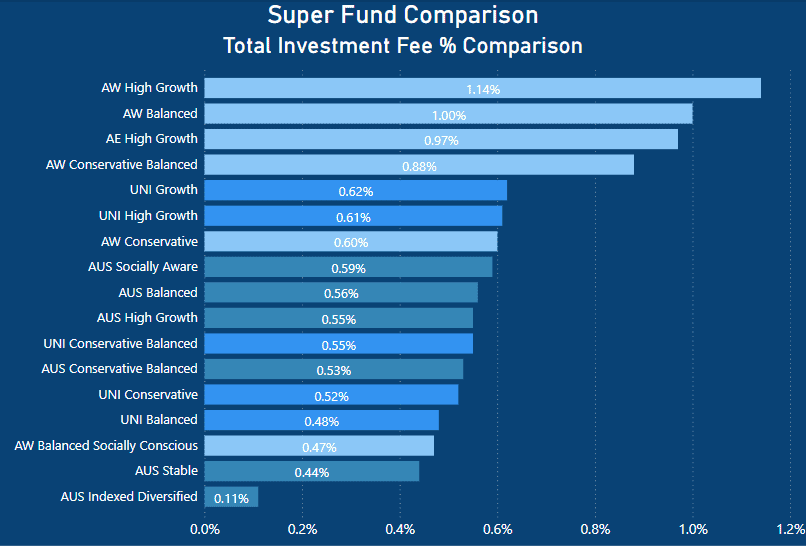
Upon analyzing investment-related fees, it becomes clear that the fee structures differ significantly depending on the particular super fund product.
However, it is noticeable that Aware Super’s investment costs for their High Growth, Balanced, and Conservative options are considerably higher than those of their competitors.
UniSuper and Australian Super, on the other hand, have options that fall within a range of 5 to 10 basis points, depending on the specific investment option.
Fee Comparison: Administrative Related Fees
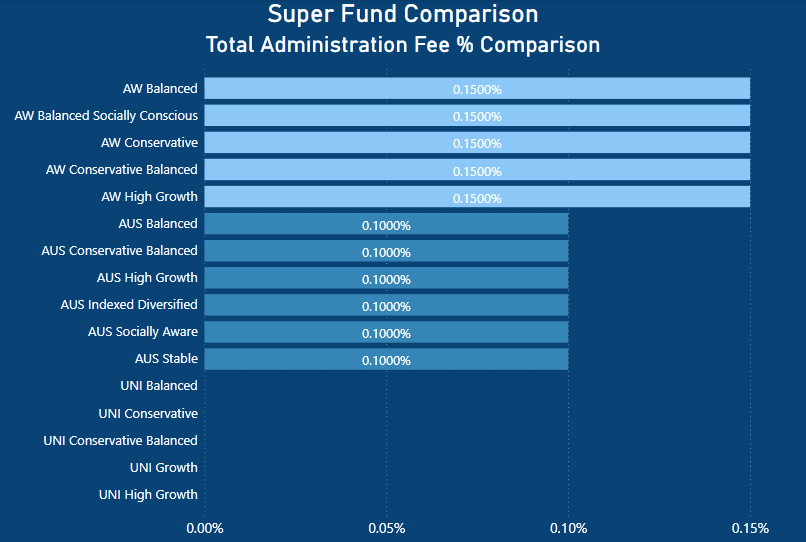
When examining the administration fee percentages, it is evident that Aware Super has the highest rate at 0.15%, followed by AustralianSuper at 0.10%.
Interestingly, UniSuper takes a different approach by not charging administration fee percentages on super fund balances above $4800. Instead, they charge an annual fee of $96.
For balances below $4800, UniSuper charges 2% of the total balance instead of the $96 annual fee.
In addition to the administrative fee percentages listed, both AustralianSuper and Aware Super charge an additional weekly fee of $1.
Fee Comparison: Total Related Fees
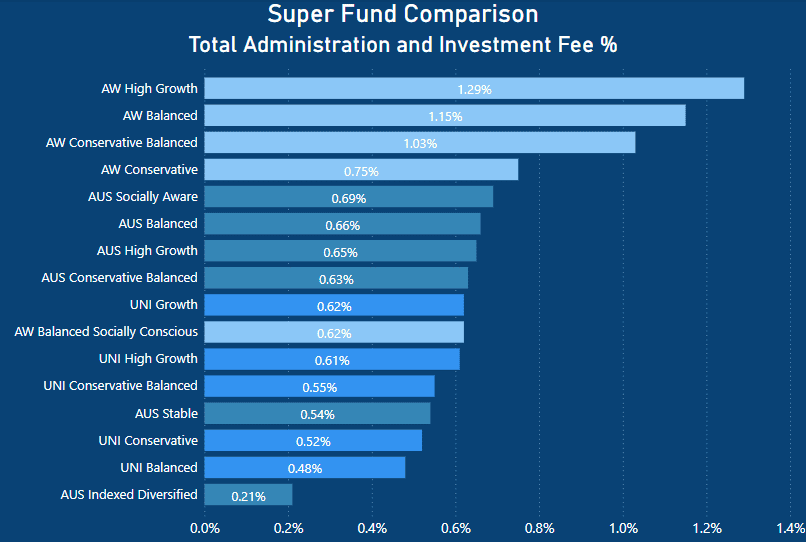
Upon evaluating the total fees charged, it is evident that Aware Super imposes the highest overall percentage-based costs. The High Growth, Balanced, and Conservative Growth options all exceed 1% in fees.
On the other hand, the remaining super options fall within the range of 54 to 62 basis points, with the exception of Australian Super’s indexed option.
It is essential to note that this chart displays fee percentages and does not include fixed dollar amounts charged by certain funds, such as Aware and Australian Super’s $1 per week fee and UniSuper’s $96 annual fee.
Top 5 – Total Fee Related Percentages for High Growth, Growth, and Balanced Options
- UniSuper Balanced – 0.48%
- UniSuper High Growth – 0.61%
- UniSuper Growth – 0.62%
- AustralianSuper High Growth – 0.65%
- AustralianSuper Balanced – 0.66%n
Now, let’s examine how this translates into actual dollar amounts for the average investor.
Fee Comparison: On a $50,000 Super Balance
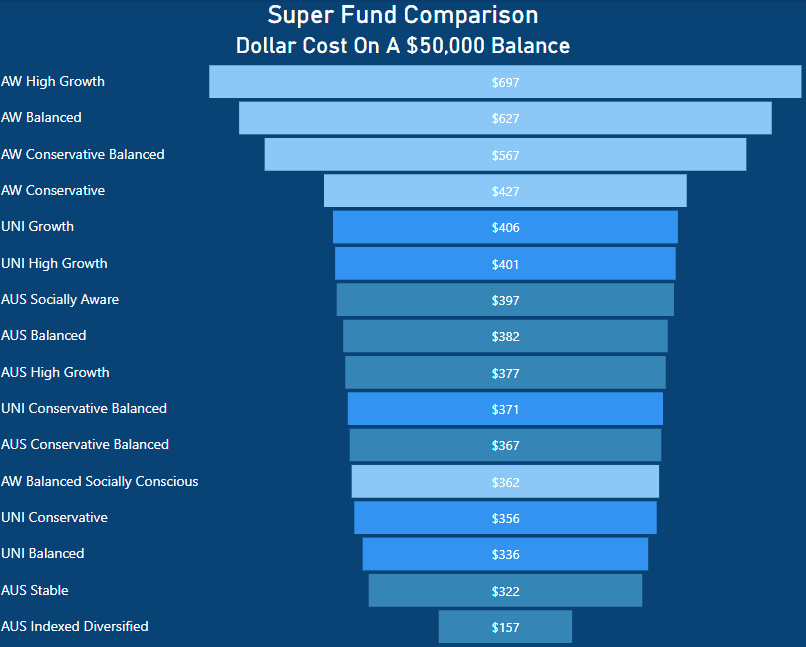
The actual costs of each Super Fund option reveal significant differences. For instance, on a balance of $50,000, Aware Super’s High Growth option would cost you $697 annually.
Similarly, Aware’s Balanced and Conservative Balanced options would cost you $627 and $567, respectively.
Some may be surprised that Australian Super and UniSuper have comparable fees, even though UniSuper does not charge an administrative fee percentage.
The Top 5 Cheapest – High Growth, Growth and Balance Options on a $50,000 balance
- UniSuper Balanced – $336
- AustralianSuper High Growth -$377
- AustralianSuper Balanced – $388
- UniSuper High Growth – $401
- UniSuper Growth – $406
Again important to note that AustralianSuper and Aware Super charge a weekly fee of $1, whereas UniSuper charges $96 per year as the balance is above $4800.
When evaluating the overall costs of the super fund options, these weekly charges should be taken into account alongside the administration percentage fee.
Fee Comparison: On a $500,000 Super Balance
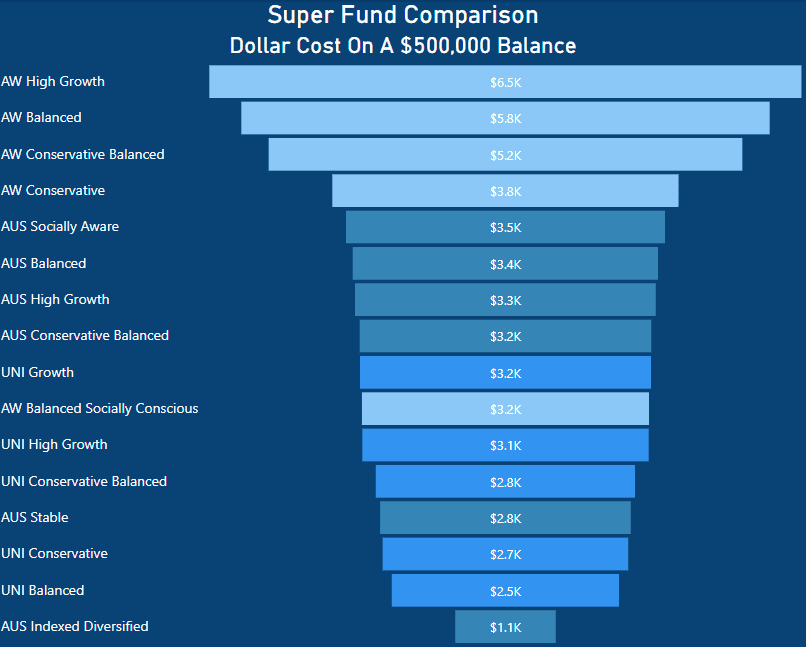
When projecting this data to a $500,000 balance, the discrepancies in fees become even more significant due to the percentage-based fees applied under each option.
Unsurprisingly, Aware Super is the most expensive option as its percentage-based fees are much higher than the competition.
Aware Super’s High Growth option will cost $6,500 per year on a half-million balance, whereas UniSuper and AustralianSuper will cost $3,200 and $3,300, respectively.
That would result in an annual saving of $2,200 – $2,300.
On a balance of $50,000, UniSuper and AustralianSuper were comparable. However, with UniSuper not charging a percentage-based administrative fee, they are typically the cheaper option.
For comparison, UniSuper’s Balanced option would cost $2,500 per year, in contrast to $3,300 for AustralianSuper’s Balanced product.
The Top 5 Cheapest – High Growth, Growth, and Balance Options on a $500,000 Balance
- UniSuper Balanced – 2,500
- UniSuper High Growth – $3150
- UniSuper Growth – $3,200
- AustralianSuper High Growth -$3,300
- AustralianSuper Balanced – $3,300
UniSuper Insurance
UniSuper Fund presents a range of insurance options to choose from within their products.
The insurance coverage offered by UniSuper includes three types:
- Total & Permanent Disablement (TPD) Cover: This option provides a lump sum payment in the unfortunate event of a permanent disability that renders you unable to work.
- Death Cover: With Death Cover, you or your nominated beneficiaries will receive a lump sum payment in case of terminal illness or death.
- Income Protection: Income Protection ensures regular payments to replace a portion of your income if you are unable to work due to illness or injury. nnThis coverage aims to maintain financial stability during challenging times.
Should You Switch to UniSuper?
When considering a switch in super funds, it is crucial to approach the decision thoughtfully and ensure that your reasoning and rationale are well-founded.
In my research on this topic, I have written an article about the process of How To Choose A Super Fund.
UniSuper has demonstrated robust performance over time, comparable to peers like Australian Super. Nonetheless, before considering switching super funds, there are several crucial factors to take into account:
Performance: Carefully assess the investment performance of the super funds you are considering. Analyze their historical returns and compare them against industry benchmarks.
While past performance does not guarantee future results, it can offer insights into how the fund has fared under various market conditions.
Fees and Charges: Thoroughly evaluate the fees and charges associated with each super fund, including administration fees, investment management fees, and other costs.
Lower fees can significantly impact your long-term returns, making it essential to understand the fee structure of the fund you are contemplating.
Investment options: Examine the variety of investment options offered within each super fund. Look for funds with a diverse range of options that align with your risk tolerance and investment objectives.
Insurance options: Check if the super fund provides insurance coverage, including life insurance, total and permanent disability (TPD) insurance, and income protection insurance.
Evaluate the cost and extent of coverage to ensure it meets your needs.
Additional features and benefits: Explore supplementary features offered by the super funds, such as online account management tools, educational resources, financial planning services, and member discounts.
Consider which features align with your financial objectives.
Fund stability and reputation: Research the stability and reputation of the super funds under consideration. Examine their track record, financial strength, and member satisfaction ratings.
Factors like the fund’s size, longevity, and ability to consistently deliver returns over time should be considered. Exit fees and insurance implications: Before switching super funds, be aware of any exit fees or penalties associated with leaving your current fund.
Additionally, consider the impact on your insurance coverage during the transition period, as most insurance policies have a waiting period before becoming active.
Review the product disclosure statement (PDS) provided by the superannuation providers to gather specific information about insurance coverage and waiting periods.
By being aware of any exit fees or penalties and understanding the insurance implications, you can effectively evaluate the potential costs and consequences associated with switching super funds.
Conclusion: Switching To UniSuper
UniSuper has some of the lowest fees I have reviewed so far. In addition to the great fees, their performance has been comparable to that of AustralianSuper, Australia’s largest Superannuation fund.
In my Vanguard Super Review, I observed that, at the time, they too were highly competitive with the likes of Australian Super. However, it’s important to note that Vanguard Super was only launched in October 2022, so its long-term performance cannot be measured yet.
Similarly, in my Australian Super Review and Aware Super Review, I observed that Australian Super had some superior performances with some of the lowest fees also.
When comparing the performance of UniSuper and AustralianSuper’s High growth option, the difference more be worth considering. UniSuper achieved a 10-year return of 10.33%, whereas AustralianSuper achieved 9.62% over the same period.
Furthermore, if you look at the same product from a fee perspective, on a $500,000 balance, UniSuper would charge $3,150 for that result, whereas AustralianSuper charges $3,300 per year.
This means that UniSuper is a good consideration for many looking for a low-fee super fund.
This article is for informational purposes only and does not constitute as an endorsement or recommendation to purchase any specific mentioned product. Past performance is not a reliable indicator of future performance.
- https://www.unisuper.com.au/about-us/media-centre/2023/unisuper-wins-chant-west-super-fund-of-the-year
- https://treasury.gov.au/sites/default/files/2019-03/UniSuper.pdf
- https://www.unisuper.com.au/about-us/who-we-are/our-people/our-board
- https://aware.com.au/member/become-a-member/what-it-means
- https://www.thinkingaheadinstitute.org/content/uploads/2022/09/PI-300-2022.pdf
- https://www.unisuper.com.au/-/media/files/pds/ibr/fees-and-costs.pdf









